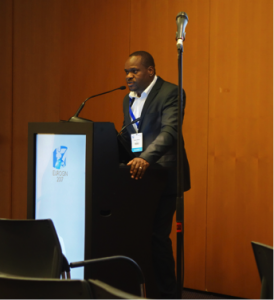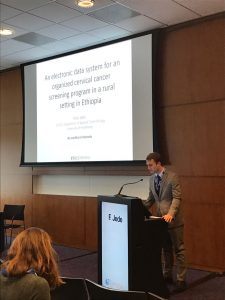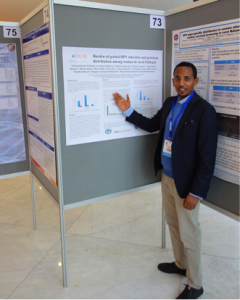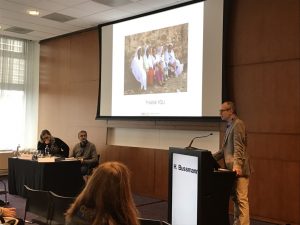One of the most common types of cancer in women worldwide is cervical cancer — with 500,000 new diagnoses each year. To date, nearly all instances of cervical cancer are a result of infections of the human papillomavirus (HPV). A vaccine has been developed to prevent HPV infection and is used frequently in the westernized countries; however, due to poor access to screening and treatment services, more than 90% of deaths from cervical cancer occur among women living in developing countries. In these areas of the world, it’s very difficult for medical personnel to identify and reach the people who need their attention.
To help overcome this disastrous situation, Heidelberg University Hospital — a prestigious medical center in Germany with a reputation based on excellent patient care, research, and teaching — discovered a way to determine which patients are at risk for cervical cancer. “A biomarker was developed a couple years ago, which is now in clinical trials for use in cervical cancer screening technologies, that allows us to identify — among these many women affected by HPV — exactly who are at risk of developing cancer as a consequence of that virus,” says Professor Magnus von Knebel Doeberitz, Medical Director, Department of Applied Tumor Biology, Institute of Pathology at the University of Heidelberg.
Even though HPV infections are widespread — the virus is so common that nearly all sexually active women will contract it at some point in their lives — only a small percentage of those infected will develop symptoms that a doctor will have to treat. Most of the infections simply clear by themselves, and the molecular changes that are required to trigger cancer development don’t happen. So the challenge is identifying exactly where the infections don’t go away and determining which women need immediate medical attention. Considering the enormous population of affected women living in the rural regions of the world, this is no small task.
“In the emerging world, particularly in Africa, the lack of infrastructure makes it difficult to defeat this type of cancer, so it is important to develop innovative screening technologies that we can apply in less privileged areas,” says von Knebel Doeberitz. “Once we had this biomarker that helped us to identify woman at risk, we started thinking about how to use technology to improve that situation where roughly nothing is available — no microscopes or laboratory facilities — so women living in those areas can benefit from the same high-tech medicine as the western world.”
The Emerging Technologies in Cervical Cancer Screening (ETiCCS) research project came about as a result, with the goal to promote global cervical cancer awareness and prevention through science, capacity building, and technology transfer. The pilot program was rolled out in Kenya, Africa — where the goal was to recruit women older than 25 years at health facilities for a cervical cancer screening study — and it was soon discovered that the screening process was rife with manual activities and a significant paper trail. As the project progressed, healthcare and IT experts from SAP joined forces with Heidelberg University Hospital to leverage IT solutions in ways that were not possible previously and to deliver medical technology to people who previously did not have access to it. “SAP is committed to improving peoples’ lives, and that’s why we see the ETiCCS project as a great opportunity for a close collaboration with Heidelberg University Hospital in the healthcare sector,” says Michael Byczkowski, ETiCCS Executive Sponsor and Vice President of Customer Design Experience at SAP. A series of iterative Design Thinking workshops and onsite user observations led to a first-of-its-kind mobile, cloud-based solution that significantly accelerated and simplified the screening approach. The mobile solution leveraged SAP Cloud Platform to provide study data online and in real time, so researchers can derive the most recent results out of the sample data without having to wait until the conclusion of the study for analysis.
“Using the biomarkers in the ETiCCS program, our digitized laboratory method can perform the cervical cancer test within a couple of days, but in Africa, it can be challenging to communicate with the lab analyzing the samples and inform the patients of the results,” says von Knebel Doeberitz. “That’s a major benefit of using SAP Cloud Platform to transfer that information back to the appropriate parties fast.”
Another challenge was the existing infrastructure at the health facilities in Kenya. “Because all the communication had been paper-based and involved duplicating handwritten information, it was difficult to extract important data,” says Dr. Hermann Bussmann, ETiCCS Project Lead, Department of Applied Tumor Biology, Institute of Pathology at the University of Heidelberg. “The ETiCCS program can revolutionize how these facilities operate, even in the most remote areas.”
Identifying and Reaching Those in Need
This pilot of the ETiCCS project consisted of a one-year study, which is currently ongoing, involving two local health centers and the Moi Teaching and Referral Hospital in Eldoret, Kenya. The goal of the study is to recruit 800 women at these local health centers in Eldoret, which is a growing urban center where internet access and cellular phone use are more common than in the rural regions of Kenya. The digitized screening process involves a cloud-based tablet app that collects all relevant information and is accessible to different researchers globally. Once the women agree to participate in the study and cell samples are taken, the screening results are analyzed at a laboratory, sent to a doctor in the hospital for further review and management, and also shared with the lead researcher located in Heidelberg University Hospital. All the information gathered is accessible by the different roles of the research project — recruiter, nurse, lab technician, doctor, and researcher — and available via SAP Cloud Platform.

With so many people in so many roles looking for one woman out of hundreds, it was more than just a question of technology. What the project team needed to consider was how these different perspectives and individual roles contribute to the whole process of saving lives. And when looking for technology, it was important to find a solution that would support these roles in their work rather than stand in the way.
Heidelberg University Hospital collaborated with the SAP Design and Co-Innovation Center to deliver a solution by leveraging the Design Thinking methodology, which is based on the cornerstones of “Discover, Design, and Deliver.” During the discovery portion of the project, a series of Design Thinking workshops were held in Germany with a diverse team of experts from both Heidelberg University Hospital and SAP. This group decided to take a user-centric design approach and to focus on the problem first and the technology second. To get to the bottom of the challenges, members of the project team traveled to Kenya to see the local area where the women lived, tour the health centers and hospitals, and interview the doctors, nurses, and participants to get a complete picture of the problem.
What this research uncovered was that the study participants were mostly living in rural areas and were key supporters of large families, so they couldn’t travel back and forth to the clinic every day. Same-day service was a requirement. The nurses each had an extremely high workload, approximately 50-100 patients per day, and did not have the time to also recruit patients eligible for the study. A separate role of recruiter would need to be established. Nurses and lab technicians documented their work with handwritten notes on paper that was then stored in binders — only one copy with no backup, confined to one location. Each health center was completely isolated in that there was no cross-location reporting or information sharing. Communication was fragmented, supported by paper and phones. A major necessity and focus of the project was easier information sharing among the various roles of the research as well as improved transparency into the status of the tests and study in general.
The team members returned to Germany armed with these important insights and ideas for Design Thinking that could optimize these processes. At this point, the technology came into play — and the project team began discussing how to create a user interface that was easily usable, ran on a mobile device, and resembled a paper form so that very little training would be required.
The SAP Custom Development team developed the solution so that each role could access the cloud application and see only information pertinent to that role. From a technology perspective, there were some challenges getting the mobile synchronization across all different locations. SAP Custom Development helped set up role-based apps implemented on a tablet as well as a web-based user interface. SAP Cloud Platform was selected as it would provide consistent access and a central database that performs all data security, authorizations, and backups. There would be no need for servers on site at the health centers. Rather, all the study data would be stored locally on the tablets, and anonymized data would be transferred via USB internet stick in the cloud and made available to researchers in Heidelberg so they could more closely monitor the study to see the current status of how many tests were performed or how many women had been recruited so far.
Recruiting and Screening Patients in the Cloud
Now that the ETiCCS mobile, cloud-based solution has been rolled out, there is a recruiter at the local health centers working alongside a nurse and informing patients in the waiting area about cervical cancer and prevention. The recruiter uses a mobile device, in the form of a tablet, and works offline, saving the recruiting information locally on the device. After conducting an initial discussion with the candidate, the recruiter gets informed consent from the her to participate in the study and performs intake to check all eligibility facts, with all information displayed on the tablet.
The mobile app, which is a simple, role-specific dashboard, shows the recruiter an opening screen displaying how many women were recruited so far that day as well as the total over time (see screenshots to the left). The recruiter can add new candidates to the study and see the latest participants recruited for the study. When the recruiter adds a candidate, the participant’s name and birthday are entered, and an internal number is assigned to that person so only anonymized data will be used thereafter for data security and privacy. Once the necessary questions are answered by the participant and entered into the tablet, the recruiter saves the information in the app and then transfers the data to the nurse’s device, who takes over the next step in the process.


The nurse sees a different individualized dashboard that shows how many new candidates were enrolled for the day, and can decide who to call up and examine. The nurse has a different set of questions displayed on the tablet to fill out that are specific to the examination, and also has access to check that the informed consent was signed and ensure that everything is in proper order. After the nurse performs the exam and collects the cell sample, he or she saves the appropriate information in the tablet and receives an on-screen confirmation, and all the data is updated in the app. The nurse can also send information about the samples to the lab technician right from the app as well as contact the participants to alert them when they have to come back to the local health center. For the purposes of consistency and data security, only the nurse uploads the patients’ data to the cloud. The process involves the nurse transferring the data from the tablet to SAP Cloud Platform via a USB internet stick twice daily, depending on internet availability, to sync the study data and provide transparency to those in the other roles.
The material samples are delivered to a specialized laboratory for examination and analysis where the biomarker testing and the HPV tests are then performed. The lab technician who physically analyzes the samples is connected to the cloud and has access to the same data through the app’s web-based user interface. After the technician performs the analysis, he or she then enters the results of the test in the ETiCCS app and sends them to a pathologist at the hospital for final interpretation. Those results are immediately available to the doctor, who then evaluates the results and decides whether the patient needs to be treated or if other follow-up measures are needed. Patients will be informed of the test results via a phone call from the nurse or by home visit when necessary. Once the doctor and the nurse save the pertinent information to the patient record in the app, the study results are updated so that the research lead back in Heidelberg University Hospital who is in charge of the study can look at the reporting across all the different activities recorded from all the various roles. And the researcher can review this information at any time to see the study progression, rather than having to wait to see results until after the study is concluded.


Paving the Way for the Rest of the World
With the mobile solution also having an offline capability, recruiters and nurses can use the tablet to collect and enter data even when they are not connected to SAP Cloud Platform. This means they can travel far from the local health center to even the most remote villages to recruit harder-to-reach women. “Now our colleagues could also go into the remote communities in Africa to register women for cancer screening, collect test samples, deliver them to labs for testing, and then transmit results to the respective patient, together with any recommendation from the doctor,” says von Knebel Doeberitz. “And the fact that you can deliver that message through the cloud to the patient from whom the sample has been taken is a big advantage and will clearly improve the screening facilities in these areas.”
Other future enhancements to the project will include rolling it out beyond tablets to mobile phones. Self-sampling will also be implemented so women can forego the exam with the nurse and submit their own cell samples. This will help increase the number of samples by including women who might have been averse to the examination itself and by freeing up the nurses’ time so they can help even more patients.
Following its goal to prevent cervical cancer in underprivileged areas of the world, the ETiCCS project is well poised to reach other countries outside Kenya. The study has already expanded to include Gondar, Ethiopia, in addition to the recruitment in Eldoret. And the hope is to expand and reach areas beyond Africa. “This problem is on a global scale everywhere infrastructure has not been as well developed,” says von Knebel Doeberitz. “We are considering implementing the same technology and conducting similar trials in areas where no cervical center tests have been developed, such as in Latin America, Asia, and Eastern European countries.”
More sponsors will be needed to support the cost of setting up the infrastructure and reshaping the solution to localize it for different locations. While there is no single solution for the screening process for different countries since each country has its own specific requirements, the underlying technology makes the app functionality easy to duplicate. “There is no one-size-fits-all solution for cervical cancer screening, but our approach can easily be adapted to many different settings,” says von Knebel Doeberitz. “We can easily transfer this app to other underprivileged areas where cervical cancer is prevalent among women who play a vital social role in the overall development of their communities.”
The ETiCCS project received much well-deserved recognition for its success in 2016. It won a first-prize Design Value Award from the Design Management Institute for improving lives according to user-centered design principles; was awarded Bronze in the Spark Design Awards; was a finalist for a Mobile Excellence Award in the Humanitarian category; and achieved an SAP HANA Innovation Award honorable mention in the Next-Gen Apps category.
“We developed a simple, primary application using SAP Cloud Platform that has never existed before and will change the medical world,” says von Knebel Doeberitz. “This success will lead us into new phases of cloud-based application development, such as in the area of digitalized pathology and medical image analysis.” For example, nurses, doctors, or technicians could upload pictures of patients or samples from the app to the cloud. Global experts then would review those images, make recommendations, and transfer the results back to the local side. “Having these initial prototype projects like the ETiCCS program now running, we see how effective IT solutions can be and how we can make a huge impact addressing other illnesses and diseases affecting the world’s vulnerable populations,” he adds.












